Saturday 22 November, 2008, 19:39 - Licensed
Posted by Administrator
Posted by Administrator
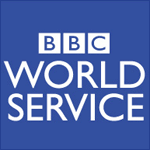 The end of an era is afoot (or at hand, whichever you prefer). Earlier this year the BBC World Service announced that it has stopped transmission of its English service to Western Europe. No longer will the strains of 'Lili Bolero' or 'Big Ben' be heard on the hour in France, Germany or anywhere east of Moscow. Or will it?
The end of an era is afoot (or at hand, whichever you prefer). Earlier this year the BBC World Service announced that it has stopped transmission of its English service to Western Europe. No longer will the strains of 'Lili Bolero' or 'Big Ben' be heard on the hour in France, Germany or anywhere east of Moscow. Or will it?The BBC claim that certain frequencies destined for other parts of the world, notably Western Russia, may still be audible in some parts of Europe for those who absolutely insist on listening to the news from London with loads of hiss, crackle, distortion and fading. But to what extent is this possible? Is World Service short wave reception in Western Europe gone forever or is there still the possibility to listen in?
A scan of the material published by the BBC shows that there are still plenty of transmitters on-air carrying BBC World Service English (albeit different regional variants), pretty much around the clock. The question therefore is whether any of them are audible in Europe.
Whether or not a short wave transmission is audible in any given place depends on a number of factors including the transmission frequency, the time of day (in particular whether the path between transmitter and receiver is in daylight or darkness), the distance between transmitter and receiver and the intended target for the transmission. Take for example the World Service English transmission to Africa from its transmitter site on Ascension Island in the South Atlantic. At various times during the (European) day, this is on a frequency of 17830 kHz. This high frequency propagates well through areas in daylight and the direction of the transmission is roughly the same as the direction from Ascension to most of Europe. The distance between Ascension and Europe requires the transmission to hop into and out of the ionosphere a couple of times but on a normal day, if both ends of the path are in daylight, this should work. Barring any co-channel or strong adjacent channel interference, therefore, the BBC transmission from Ascension should be (and indeed is) audible in Europe.
During the hours of darkness, low frequencies (the 48, 41 and 31 metre band for example) tend to propagate well, whereas during the day, higher frequencies (the 25, 19 and 16 metre bands) will fare better. Taking all this into account, it should be possible to construct a schedule of which BBC World Service English programmes are most likely to be heard in Europe. Of course this will change twice a year as the winter and summer schedules take effect, but the principles should hold true.
With that in mind, here is the Wireless Waffle guide to receiving BBC World Service English in Europe on short wave. The frequencies shown are those that have the best chance of being received in Europe but which are directed to other regions (thus the programming material may not necessarily be appropriate). No account of possible interference has been made (for example it is known that the BBC frequency of 17640 kHz suffers strong adjacent channel interference in Europe from Africa No. 1 on 17630 kHz and China Radio International on 17650 kHz). Other frequencies have strong co-channel and adjacent channel interference too so it's definitely a case of 'if at first you don't succeed, try, try, try again'.
Midnight (GMT) to Dawn
Try:
5970 kHz (from Oman)
6005 kHz (from South Africa/Ascension)
6145 kHz (from Ascension)
6190 kHz (from South Africa)
6195 kHz (from Cyprus)
7105 kHz (from Oman)
7255 kHz (from Ascension)
7320 kHz (from Cyprus)
9410 kHz (from various sites)
9650 kHz (from South Africa)
11760 kHz (from Oman/Cyprus)
11765 kHz (from Oman/Portugal)
12035 kHz (from Cyprus)
12095 kHz (from Cyprus)
Daytime
Try:
11760 kHz (from Oman)
15105 kHz (from South Africa)
15310 kHz (from Thailand)
15400 kHz (from Ascension)
15420 kHz (from Cyprus/South Africa)
17640 kHz (from the Seychelles)
17830 kHz (from Ascension)
21470 kHz (from Ascension)
Dusk to Midnight
Try:
3915 kHz (from Singapore)
5875 kHz (from UK/Cyprus)
5955 kHz (from Oman/Singapore)
6155 kHz (from South Africa)
6190 kHz (from South Africa)
7445 kHz (from South Africa)
12095 kHz (from Cyprus)
Note that these frequencies were taken from the Winter 2008/9 broadcast schedule and may be very out of date if you are reading this in 2013! Also, not all frequencies are on for the whole period (some are not daily either), so you will have to tune around between the ones listed to find the best possible reception for the time you are listening.
add comment
( 1697 views )
| permalink
| 



 ( 3.1 / 95889 )
( 3.1 / 95889 )




 ( 3.1 / 95889 )
( 3.1 / 95889 )
Friday 8 February, 2008, 19:10 - Licensed
Posted by Administrator
Posted by Administrator
 The Wireless Waffle team used to supply VHF FM radio transmitters for Restricted Service Licence (RSL) stations in the UK. The licences allowed a maximum transmitter power of 25 Watts and a maximum antenna height of 10 metres above the ground. As such, the range of such stations was normally very limited compared to regular FM stations who used powers typically in excess of 400 Watts and with much higher antennas. To maximise the range of the RSLs, it was best to identify and use transmitter sites which were as high above the surrounding land as possible but in some areas the land was so flat that no such sites existed.
The Wireless Waffle team used to supply VHF FM radio transmitters for Restricted Service Licence (RSL) stations in the UK. The licences allowed a maximum transmitter power of 25 Watts and a maximum antenna height of 10 metres above the ground. As such, the range of such stations was normally very limited compared to regular FM stations who used powers typically in excess of 400 Watts and with much higher antennas. To maximise the range of the RSLs, it was best to identify and use transmitter sites which were as high above the surrounding land as possible but in some areas the land was so flat that no such sites existed.One question which was constantly asked by the operators of such stations was, "Should I broadcast in stereo?". On the face of it, stereo is the norm for FM broadcasts and most stations believed that if they weren't in stereo they would be seen somehow as inferior. However, what most failed to take into account was the fact that in order to receive a good quality stereo signal, the signal strength has to be 10 times (20dB) higher than that required to receive a good quality mono signal. This translates into a reduction in coverage area of 100 times, i.e. the coverage in stereo is only a hundredth of the coverage area achieved by the same transmitter in mono (ignoring topographical issues such as terrain and buildings).
Why is there so much difference? The answer lies in the bandwidth which a stereo signal occupies compared to a mono signal. The audio bandwidth of an FM transmission lies in the range of 30 Hz to 15000 Hz (15 kHz). However the way that a stereo signal is generated expands this bandwidth to 53000 Hz (53 kHz). (Don't get this confused with the RF bandwidth of the signal which is 180 kHz for mono and 256 kHz for stereo).
 How does the audio bandwidth extend to 53 kHz? Well the mono signal which is made by adding the left (L) and right (R) channels together - expressed as L+R - is transmitted as usual so that the resulting signal is compatible with mono receivers. The difference between the left and right channel (L-R) is amplitude modulated onto a carrier at 38000 Hz (38kHz). This produces a signal which occupies the audio frequencies from 23 to 53 kHz - above the standard audio range and thus inaudible on a mono receiver.
How does the audio bandwidth extend to 53 kHz? Well the mono signal which is made by adding the left (L) and right (R) channels together - expressed as L+R - is transmitted as usual so that the resulting signal is compatible with mono receivers. The difference between the left and right channel (L-R) is amplitude modulated onto a carrier at 38000 Hz (38kHz). This produces a signal which occupies the audio frequencies from 23 to 53 kHz - above the standard audio range and thus inaudible on a mono receiver.A 'pilot' tone which is a low-level tone at 19000 Hz (19kHz) is also added to this signal and then the whole lot is sent to the FM transmitter. In a stereo receiver the presence of the pilot tone triggers the stereo decoder to recover the original signals. The left channel is reproduced by adding the mono to the stereo difference signal (L+R+L-R=2L) and the right channel is produced by subtracting the difference signal from the mono signal (L+R-(L-R)=L+R-L+R=2R).
The noise received by an FM receiver increases as the square of the bandwidth of the modulated/demodulated signal and as such the increase in noise (i.e. the decrease in signal to noise) for a stereo signal is (53/15)² or 12.5 times. Some of this increase is counterbalanced by 'pre-emphasis' where higher audio frequencies are enhanced before transmission and then reduced at the receiver, reducing the effect of some of the noise. The resulting improvement leaves a difference of the factor of 10 mentioned above.
 The question of whether to broadcast in stereo for a low-power RSL (or indeed a pirate!) FM station is therefore a question of quality and coverage. If you have a high site and can expect that most of the listeners you wish to target will receive a good strong signal, stereo is great. If not (which is usually the case), using mono ensures your coverage is maximised. Of course, in fringe stereo areas where the signal becomes 'hissy' the listeners could always switch to mono, but how many people actually know that this solves the problem, let alone know where the mono/stereo switch on their receiver is?!
The question of whether to broadcast in stereo for a low-power RSL (or indeed a pirate!) FM station is therefore a question of quality and coverage. If you have a high site and can expect that most of the listeners you wish to target will receive a good strong signal, stereo is great. If not (which is usually the case), using mono ensures your coverage is maximised. Of course, in fringe stereo areas where the signal becomes 'hissy' the listeners could always switch to mono, but how many people actually know that this solves the problem, let alone know where the mono/stereo switch on their receiver is?!There are some pirate stations who transmit only the pilot tone so that the stereo 'light' on receivers comes on, which looks nice, but don't actually transmit in stereo. This is the worst possible case, as all it will serve to do is reduce the coverage, without giving any additional benefit to the listeners!
Monday 19 February, 2007, 04:47 - Licensed
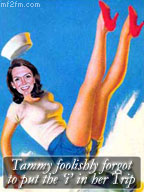 So you've bought your iTrip, micro FM transmitter, AirPlay, PodFreq or similar and plugged it into your iPod or PSP and managed to get it to transmit somewhere in the FM band. You even manage to find a clear FM frequency at home where you don't suffer interference from local radio transmitters (or your neighbours' iTrips!) Then you decide to go on a road trip and you take it into your car. Driving around the UK you soon find that the FM frequency that was clear at home is home to a neighbouring radio station and that as you drive along, reception of your iTrip is blighted by interference from local radio stations (how dare they!)
So you've bought your iTrip, micro FM transmitter, AirPlay, PodFreq or similar and plugged it into your iPod or PSP and managed to get it to transmit somewhere in the FM band. You even manage to find a clear FM frequency at home where you don't suffer interference from local radio transmitters (or your neighbours' iTrips!) Then you decide to go on a road trip and you take it into your car. Driving around the UK you soon find that the FM frequency that was clear at home is home to a neighbouring radio station and that as you drive along, reception of your iTrip is blighted by interference from local radio stations (how dare they!)What you need is a frequency somewhere in the FM band that is clear of licensed stations so that you can drive up and down the country without ever suffering interference or having to re-tune your iTrip. Dream on! There are only nine frequencies in the mainland UK which are not used by high powered local (or national) radio stations, these being 87.5, 87.6, 87.7, 87.8, 87.9, 88.0, 105.0, 105.5 and 108.0 MHz. If you include pirate radio stations on the list, there are virtually no clear frequencies at all - Shine on 87.9, Point Blank on 108.0 and UK's Finest on 87.5 being good examples of stations that occupy these seemingly clear channels. However to get clear, interference-free reception it's wise to have at least 200 kHz between you and any other station. Pirates aside, this means that 88.0, 105.0, 105.5 and 108.0 are out leaving only 87.5 - 87.9 MHz. This 'clear' spectrum is not, however, unused: 87.7 and 87.8 MHz are the most common frequencies for low-power FM stations, either short term (RSL) stations, or the new wave of community radio stations.
So what to do? Well excluding one or two pirates, using 87.5 MHz is a fairly safe bet, unless you happen to live in a major city where pirates are prevalent or near a long-term RSL or community station on 87.7. But what about elsewhere on the FM dial? Are there any 'cold-spots' where there is a smaller likelihood of coming across an interfering station.
The main BBC sub-bands (88.1 - 90.2 for Radio 2, 90.3 - 92.4 for Radio 3, 92.5 - 94.6 for Radio 4, and Radio Scotland and 97.7 - 99.8 MHz for Radio 1) are pretty chocker-block and many of the transmitters are very high power (250 kW is not totally uncommon) so they are not a good place to look. The other BBC sub-bands, 94.7 - 96.0 and 103.5 - 104.9 MHz or thereabouts, used for BBC local radio, or BBC Radio 4 in Scotland, BBC Wales and BBC Cymru and are also shared with independent local radio (ILR) in places, are pretty busy too. Not doing too well so far... However, an analysis of the ILR bands (96.1 - 97.6 and 99.9 - 103.4 MHz and 105.0 to 107.9) shows some interesting anomolies.
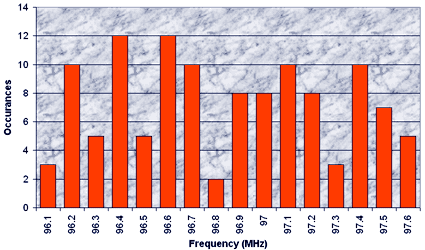
In the lower of these two bands, the frequency 96.8 is only used twice (though it is home to a whacking 250kW BBC Cymru transmission in Wales) and 96.1 and 97.3 are only used 3 times.
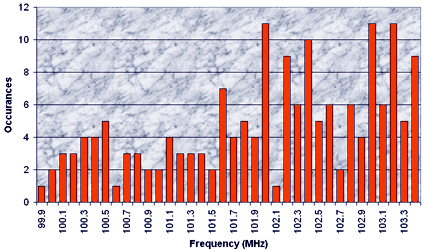
In the range 99.9 to 103.4, 99.9, 100.6 and 102.1 MHz are only used once (though the band 99.9 to 102.0 is repleat with very high powered Classic FM transmitters) and there are several frequencies only used twice across the UK. Finally, in the range 105.0 to 107.9, the frequencies 105.0 and 105.5 MHz are not used at all, and the frequencies 105.1, 105.3, 105.9, and 106.5 MHz are only used once.
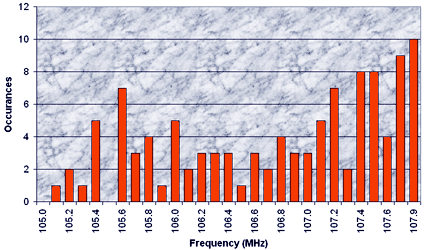
Although this analysis is based on slightly old data (2005) published by Ofcom it does tend to suggest that in addition to 87.5, there are other frequencies which might provide relatively interference free iTrip usage across the UK without needing to re-tune. Unless your local station happens to be one one of these frequencies (or one adjacent to it), I would suggest 99.9, 105.0 (or 105.1) and 106.5 MHz as possible alternatives.
Wednesday 20 September, 2006, 12:08 - Licensed
 As anyone who has bought a new television in the UK in the past year or so will know, it is the Government's intention to close down all analogue TV transmitters by the end of the year 2012. It's main reason for doing this is to release some of the channels used for broadcasting so that they can be used for 'new users' (presumably ones that they see as being more lucrative!)
As anyone who has bought a new television in the UK in the past year or so will know, it is the Government's intention to close down all analogue TV transmitters by the end of the year 2012. It's main reason for doing this is to release some of the channels used for broadcasting so that they can be used for 'new users' (presumably ones that they see as being more lucrative!)The plan is for a rolling conversion of all television transmitters in the country to change from analogue to digital. In doing this, of the four existing analogue frequencies used to carry BBC1, BBC2, ITV1 and Channel 4, only three of these will continue to be used - one will be freed for the aforementioned mysterious new users. The three frequencies still in use will carry three digital mulitplexes ensuring national provision of all BBC, ITV, Channel 4 services including CBBC, BBC News 24, ITV2, ITV3, E4 and so on, so there's no need to worry about people losing their favourite programmes. At the 80 transmitter sites that already carry digital services of the 4 (or 5) analogue frequencies in use and the 6 digital frequencies in use, only 6 will remain in use, the remainder falling into the pot of those available for other users.
Once the digital switch-over (as it's know) is complete, only UHF channels 21 to 30 and 41 to 62 will still be available for television broadcasting. Channels 31 to 40 and 63 to 68 (and possibly 69) will be freed for new users. The diagram below illustrates this situation. 'S.A.B.' represents services ancilliary to broadcasting (sometimes known as programme making and special events) and includes radiomicrophones, talkback, remote control for cameras, point-to-point audio links - i.e. radio equipment used by people making programmes. Channel 69 is shown hashed as it's not yet clear whether or not it will be given over to new users or remain with S.A.B.
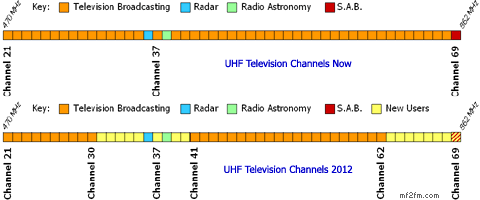
So how can the necessary channels be crammed into two-thirds of the original spectrum? There are now approximately 5,200 individual television transmitters on-air in the UK amounting to around 115 transmitters per available UHF TV channel. After switch-over the number of transmitters will be reduced to around 3,800 - but this has to be squeezed into only 32 channels amounting to around 118 transmitters per channel. So the number of transmitters per channel remains roughly the same, and therefore, in theory, planning the new network should be no more difficult than planning the old one was.
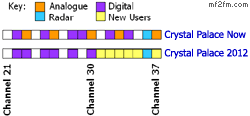 Let's take a look at a practical example, using the Crystal Palace television transmitter site which serves around 12 million people in and around London. At present channels 23, 26, 30, 33 and 37 are used for analogue transmissions and channels 22, 25, 28, 29, 32 and 34 are used for digital. Of these, channels 32, 33, 34 and 37 will no longer be available for broadcasting after switch-over as they are part of the channels set aside for new users.
Let's take a look at a practical example, using the Crystal Palace television transmitter site which serves around 12 million people in and around London. At present channels 23, 26, 30, 33 and 37 are used for analogue transmissions and channels 22, 25, 28, 29, 32 and 34 are used for digital. Of these, channels 32, 33, 34 and 37 will no longer be available for broadcasting after switch-over as they are part of the channels set aside for new users. So after switch-over, a combination of the existing analogue and digital channels (i.e. channels 22, 23, 25, 26, 28 and 30) will be used for the purely digital service. Thus the future all-digital transmissions can be squeezed into the remaining broadcasting channels at this particular transmitter site.
 This situation is also fine at the majority of UK transmitter sites including the smaller ones as typically at least 3 of the 4 channels in use at these smaller sites will fall within the untouched broadcast spectrum. Some jiggery-pokery will be necessary at a small number of sites to squash services into the remaining channels but all-in-all the plan works!
This situation is also fine at the majority of UK transmitter sites including the smaller ones as typically at least 3 of the 4 channels in use at these smaller sites will fall within the untouched broadcast spectrum. Some jiggery-pokery will be necessary at a small number of sites to squash services into the remaining channels but all-in-all the plan works!The question remains as to what 'new uses' might be made of the freed spectrum. One possiblity is that it might be used for more digital television (maybe mobile TV, portable TV or HD-TV). It might be used for more celluar services (maybe 4G). It might be used for mobile delivery of wireless broadband (maybe using 802.20). Some of it might be needed to house all the displaced S.A.B. users who currently occupy channel 69 (and to a lesser extent also heavily occupy channels 63 to 68). At present it's anyone's guess as to the need for and use of this spectrum but one thing is for certain, the UK Government will be rubbing their hands together in glee at the potential for raising a pot of gold for selling it.


